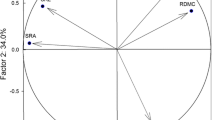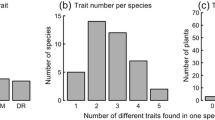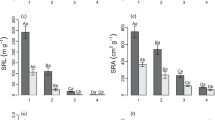Abstract
Aims
Inter-specific comparisons of plant traits may vary depending on intra-specific variation. Here we examine the impact of root branching order and season on key functional root traits for grass species. We also compare root traits among co-existing grass species as a step towards defining root trait syndromes.
Methods
Monocultures of 13 grass species, grown under field conditions and subjected to intensive management, were used to record root trait values for coarse roots (1st order, >0.3 mm), fine roots (2nd and 3rd orders, <0.2 mm) and mixed root samples over three growing seasons.
Results
Branching order and species had a significant effect on root trait values, whereas season showed a marginal effect. The diameter of coarse roots was more variable than that of fine roots and, as expected, coarse roots had higher tissue density and lower specific root length values than fine roots. Principal component analysis run on eight root traits provided evidence for two trait syndromes related to resource acquisition and conservation strategies across grass species.
Conclusions
Our data show that root branching order is the main determinant of root trait variation among species. This highlights the necessity to include the proportion of fine vs coarse roots when measuring traits of mixed root samples.



Similar content being viewed by others
References
Bouma TJ, Nielsen KL, Koutstaal B (2000) Sample preparation and scanning protocol for computerised analysis of root length and diameter. Plant Soil 218:186–196
Canadell J, Jackson RB, Ehleringer JR, Mooney HA, Sala OE, Schulze ED (1996) Maximum rooting depth of vegetation types at the global scale. Oecologia 108:583–595
Comas LH, Bouma TJ, Eissenstat DM (2002) Linking root traits to potential growth rate in six temperate tree species. Oecologia 132:34–43
Comas LH, Eissenstat DM (2004) Linking fine root traits to maximum potential growth rate among 11 mature temperate tree species. Funct Ecol 18:388–397
Comas LH, Eissenstat DM (2009) Patterns in root trait variation among 25 co-existing North American forest species. New Phytol 182:919–928
Cornelissen JHC, Lavorel S, Garnier E et al (2003) A handbook of protocols for standardised and easy measurement of plant functional traits worldwide. Aust J Bot 51:335–380
Craine JM, Froehle J, Tilman DG, Wedin DA, Chapin FS (2001) The relationships among root and leaf traits of 76 grassland species and relative abundance along fertility and disturbance gradients. Oikos 93:274–285
Craine JM, Wedin DA, Chapin FS III, Reich PB (2002) Relationship between the structure of root systems and resource use for 11 North American grassland plants. Plant Ecol 165:85–100
Craine JM, Wedin DA, Chapin FS III, Reich PB (2003) The dependence of root system properties on root system biomass of 10 North American grassland species. Plant Soil 250:39–47
Drouet JL, Pagès L, Serra V (2005) Dynamics of leaf mass per unit leaf area and root mass per unit root volume of young maize plants, Implications for growth models. Eur J Agron 22:185–193
Eissenstat DM, Yanai RD (1997) The ecology of root lifespan. Adv Ecol Res 27:1–60
Fitter AH (1987) An architectural approach to the comparative ecology of plant root systems. New Phytol 106:61–77
Fitter AH, Peat HJ (1994) The ecological flora database. J Ecol 82:415–425
Fitter AH (2002) Characteristics and functions of root systems. In: Waisel Y, Eshel A, Kafkafi U (eds) Plant roots, the hidden half. Dekker M Inc, New York, pp 15–47
Fornara DA, Tilman D, Hobbie SE (2009) Linkages between plant functional composition, fine root processes and potential soil n mineralization rates. J Ecol 97:48–56
Garcia-Pausas J, Casals P, Romanyà J, Vallecillo S, Sebastià M-T (2010) Seasonal patterns of belowground biomass and productivity in mountain grasslands in the Pyrenees. Plant Soil. doi:10.1007/s11104-010-0601-1
Garnier E (1992) Growth analysis of congeneric annual and perennial grass species. J Ecol 80:665–675
Garnier E, Laurent G, Bellmann A, Debain S, Berthelier P, Ducout B, Roumet C, Navas ML (2001) Consistency of species ranking based on functional leaf traits. New Phytol 152:69–83
Garwood EA (1967) Seasonal variation in appearance and growth of grass roots. J Br Grass Soc 22:121–130
Gill RA, Jackson RB (2000) Global patterns of root turnover for terrestrial ecosystems. New Phytol 147:13–31
Gill RA, Burke IC, Lauenroth WK, Milchunas DG (2002) Longevity and turnover of roots in the shortgrass steppe, influence of diameter and depth. Plant Ecol 159:241–251
Grime JP, Hodgson JG, Hunt R (1988) Comparative plant ecology: a functional approach to common British species. Unwin Hyman Ltd, London
Grime JP, Thompson K, Hunt R, Hodgson JG, Cornelissen JHC, Rorison IH, Hendry GAF, Ashenden TW, Askew AP, Band SR et al (1997) Integrated screening validates primary axes of specialisation in plants. Oikos 79:259–281
Guo D, Xia M, Wei X, Chang W, Liu Y, Wang Z (2008) Anatomical traits associated with absorption and mycorrhizal colonization are linked to root branch order in 23 Chinese temperate tree species. New Phytol 180:673–683
Hummel I, Vile D, Violle C, Devaux J, Ricci B, Blanchard A, Garnier E, Roumet C (2007) Relating root structure and anatomy to whole-plant functioning in 14 herbaceous Mediterranean species. New Phytol 173:313–321
Kattge J, Diaz S, Lavorel S et al (2011) TRY—a global database of plant traits. Glob Chang Biol 17:2905–2935
Kleyer M, Bekker RM, Knevel IC, Bakker JP, Thompson K, Sonnenschein M, Poschlod P, van Groenendael JM, Klimes L, Klimesová J et al (2008) The LEDA traitbase, a database of life-history traits of the Northwest European flora. J Ecol 96:1266–1274
Klumpp K, Soussana J-F (2009) Using functional traits to predict grassland ecosystem change: a mathematical test of the response-and-effect trait approach. Glob Chang Biol 15:2921–2934
Kühn I, Durka W, Klotz S (2004) Biolflor; a new plant-trait database as a tool for plant invasion ecology. Divers Distrib 10:363–365
Kutschera L, Lichtenegger E (1982) Wurzelatlas mitteleuropäischer grünlandpflanzen. Band I, monocotyledoneae. Gustav Fischer Verlag, Stuttgart
Louault F, Pillar VD, Aufrere J, Garnier E, Soussana JF (2005) Plant traits and functional types in response to reduced disturbance in a semi-natural grassland. J Veg Sci 16:151–160
Maire V, Gross N, Pontes L, Picon-Cochard C, Soussana JF (2009) A trade-off between root N acquisition and shoot N utilisation across 13 co-occurring pasture grass species. Funct Ecol 23:668–679
Matthew C, Xia JX, Chu ACP, Mackay AD, Hodgson J (1991) Relationship between root production and tiller appearance rates in perennial ryegrass (Lolium perenne L.). In: Atkinson D (ed) Plant root growth—an ecological perspective. Blackwell, Oxford, pp 281–290
Mokany K, Ash JL (2008) Are traits measured on pot grown plants representative of those in natural communities? J Veg Sci 19:119–126
Nicotra AB, Babicka N, Westoby M (2002) Seedling root anatomy and morphology, an examination of ecological differentiation with rainfall using phylogenetically independent contrasts. Oecologia 130:136–145
Ostonen I, Puttsepp U, Biel C et al (2007) Specific root length as an indicator of environmental change. Plant Biosystems 141:426–442
Personeni E, Loiseau P (2005) Species strategy and N fluxes in grassland soil—a question of root litter quality or rhizosphere activity? Eur J Agron 22:217–229
Picon-Cochard C, Pilon R, Revaillot S, Jestin M, Dawson L (2009) Use of near-infrared reflectance spectroscopy to predict the percentage of dead versus living grass roots. Plant Soil 317:309–320
Pierret A, Doussan C, Capowiez Y, Bastardie F, Pagès L (2007) Root functional architecture, a framework for modeling the interplay between roots and soil. Vadose Zone J 6:269–281
Pontes LDS, Soussana JF, Louault F, Andueza D, Carrère P (2007) Leaf traits affect the above-ground productivity and quality of pasture grasses. Funct Ecol 21:844–853
Poorter H, Van Der Werf A, Atkin OK, Lambers H (1991) Respiratory energy requirements of roots vary with the potential growth rate of a plant species. Physiol Plant 83:469–475
Pregitzer KS, Kubiske ME, Yu CK, Hendrick RL (1997) Relationships among root branch order, carbon, and nitrogen in four temperate species. Oecologia 111:302–308
Roumet C, Urcelay C, Diaz S (2006) Suites of root traits differ between annual and perennial species growing in the field. New Phytol 170:357–368
Ryser P, Lambers H (1995) Root and leaf attributes accounting for the performance of fast- and slow-growing grasses at different nutrient supply. Plant Soil 170:251–265
Ryser P (1996) The importance of tissue density for growth and life span of leaves and roots, a comparison of five ecologically contrasting grasses. Funct Ecol 10:717–723
Ryser P (1998) Intra- and interspecific variation in root length, root turnover and the underlying parameters. In: Lambers H, Poorter H, Van Vuuren MMI (eds) Inherent variation in plant growth. Physiological mechanisms and ecological consequences. Backhuys Publishers, Leiden, pp 441–465
Ryser P, Eek L (2000) Consequences of phenotypic plasticity vs. interspecific differences in leaf and root traits for acquisition of aboveground and belowground resources. Am J Bot 87:402–411
Ryser P (2006) The mysterious root length. Plant Soil 286:1–6
Schläpfer B, Ryser P (1996) Leaf and root turnover of three ecologically contrasting grass species in relation to their performance along a productivity gradient. Oikos 75:398–406
Soussana JF, Teyssonneyre F, Picon-Cochard C, Dawson L (2005) A trade-off between nitrogen uptake and use increases responsiveness to elevated CO2 in infrequently cut mixed C3 grasses. New Phytol 166:217–230
Steinaker DF, Wilson SD, Peltzer DA (2010) Asynchronicity in root and shoot phenology in grasses and woody plants. Glob Chang Biol 16:2241–2251
Stone B (2006) Explorations on the cell walls of grasses and cereals. In: Hayashi T (ed) The science and lore of the plant cell wall. Biosynthesis, structure and function. BrownWalker, Boca Raton, pp 132–139
Tarroux E (2005) Comparaison de la respiration sol-racines de 13 monocultures de graminées. MSc report, University of Blaise Pascal, Clermont-Ferrand, p 36
Tjoelker MG, Craine JM, Wedin D, Reich PB, Tilman D (2005) Linking leaf and root trait syndromes among 39 grassland and savannah species. New Phytol 167:493–508
Van Soest PJ, Wine RH (1967) Use of detergents in the analysis of fibrous feeds. IV. Determination of plant cell-wall constituents. J Assoc Off Anal Chem 50:50–55
Wahl S, Ryser P (2000) Root tissue structure is linked to ecological strategies of grasses. New Phytol 148:459–471
Waisel Y, Eishel A (2002) Functional diversity of various constituents of a single root system. In: Waisel Y, Eshel A, Kafkafi U (eds) Plant roots, the hidden half. Marcel Dekker, New York, pp 157–174
Westoby M (1998) A leaf-height-seed (LHS) plant ecology strategy scheme. Plant Soil 199:213–227
Wright IJ, Reich PB, Westoby M et al (2004) The worldwide leaf economics spectrum. Nature 428:821–827
Zobel RW (2003) Fine roots—discarding flawed assumptions. New Phytol 160:276–279
Zobel RW (2011) A developmental genetic basis for defining root classes. Crop Sci 51:1410–1413
Acknowledgments
We thank Sandrine Revaillot and Angélique Corrent for root collection, preparation and morphology measurements. We also thank Bernard Pons, Sylvie Toillon and Jean-Marie Vallée for their technical assistance in the field. We would like to thank Rocio Perrez Gonzalez, Jasmine Ross and Andy Midwood from the James Hutton Research Institute. We are grateful to Juliette Bloor for her comments on a previous version of the paper and to Leigh Gebbie for the English improvement of the paper and to three anonymous reviewers for previous version of the paper. This work was supported by the French government through GEOTRAITS and GDR UTILITERRES projects and by the INRA EFPA Research Department (“Utilisation du NIRS pour prédire la proportion et la composition chimique de litières racinaires de graminées prairiales”). The work of authors Dawson and Robertson is funded by the Scottish Government's Rural and Environment Science and Analytical Services (RESAS) Division.
Author information
Authors and Affiliations
Corresponding author
Additional information
Responsible Editor: Peter J. Gregory.
Electronic supplementary material
Below is the link to the electronic supplementary material.
Table S1
Spring, summer and autumn root diameter (mm), root tissue density (g cm−3) and specific root length (m g−1) for all root branching orders of 13 monoculture-grown grass species subjected to six cuts per year and N fertilisation (360 kg N ha−1 year−1). CVs and CVsp are coefficient of variation among season within species and among species within season, respectively. Values are expressed as means (standard error). For each species and season, n = 3. (DOC 177 kb)
Table S2
Spring, summer and autumn root nitrogen content (RNC,%), root neutral detergent fibre (NDF,%), root acid detergent fibre (ADF,%), and root lignin (%) for all root branching orders of 13 monoculture-grown grass species subjected to six cuts per year and N fertilisation (360 kg N ha−1 year−1). CVs and CVsp are coefficient of variation among season within species and among species within season, respectively. Values are expressed as means (standard error). For each species, n = 3; nd: not determined due to only one replicate. (DOC 62 kb)
Rights and permissions
About this article
Cite this article
Picon-Cochard, C., Pilon, R., Tarroux, E. et al. Effect of species, root branching order and season on the root traits of 13 perennial grass species. Plant Soil 353, 47–57 (2012). https://doi.org/10.1007/s11104-011-1007-4
Received:
Accepted:
Published:
Issue Date:
DOI: https://doi.org/10.1007/s11104-011-1007-4




